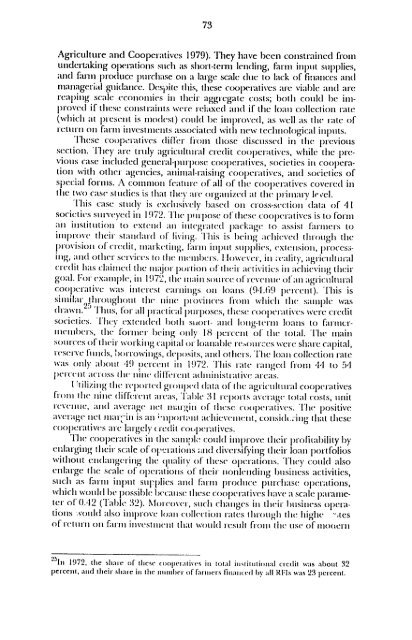I Fiance Apicultural
I Fiance Apicultural
I Fiance Apicultural
You also want an ePaper? Increase the reach of your titles
YUMPU automatically turns print PDFs into web optimized ePapers that Google loves.
73<br />
Agriculture and Cooperatives 1979). T]iey have been constrained fiom<br />
undertaking operations such as short-term lending, farin input supplies,<br />
and farm prodtuce purchase ol a large scac due to lack of finances and<br />
managerial guidance. Despite this, these cooxelratives are viable and are<br />
reaping scale economics ill their aggregate costs; both could be miproved<br />
if these conStiaints wtre relaxed and if tihe loan collection rate<br />
(which at present is modest) could be improved, as well as tle rate of<br />
return on fari invest ttits associated with new technological iniplits.<br />
These cooperIatives differ firom those discussed in the previois<br />
section. "lu1cy are truly agricultural credit cooperatives, while tie previous<br />
case included general-purpose cooperatives, societies ill cooperation<br />
with other agencies, animal-raising cooperatives, and societies of<br />
special forms. A common feature of all of the Cl operatives covered inl<br />
tile two case studies is that they are organized at the primarylevel.<br />
This Case study is exclisively based on cross-section data of 41<br />
societies survcycd ill 1972. 'I'l- pirpose of these cooperatives is to forni<br />
all institution to extend all integrated J)aclagc to assist farmers to<br />
im)rove their standard of' living. This is being achicved through tihe<br />
provision o" credit, inaiketing, faint input supplies, extension, processitg,<br />
and other services to thew titbers. I lowevVr, ill ;(cality, agriciltral<br />
credit has claiimicd the mtajor portion of ilhcir activities ill aclieving their<br />
goal. For example, ill 1972, lte maitn source of revenl ofa lagricultural<br />
cooperative was interest earnings on loans (9'.9 percent). This is<br />
similar throughout tl nine plovinices froti which tile sample was<br />
drawn. 25 T huts, for all ipractical )r)oses, these coo])pralives were credit<br />
societies. They uxtc ldcidholh)sitol- ald lotng-tcrti loans to farit ncriettbers,<br />
the fortiter being only 18 percent of tle total. 'The main<br />
sources of their working capital or loanable retourt:cs were share capital,<br />
eserve fiiids, Iorrowings, deposits, and others. Thie loan collection rate<br />
was only about 49 percett ill 1972. This rate rangcd front +t1 to 54<br />
l×,tcclit across lic nine diH'f ct admiiuistralivc: areas.<br />
t tilizitng the rl)ortcd grouped data of the agricuuilral cooperatives<br />
front the iiiie different areas, 'able 31 reports average total costs, unit<br />
revctne, and average net muaigin of thtse cooperatives. The positive<br />
average ret itlar-itt is an ;iipotrl;ml achievettinlt, cotisidt.;ing that these<br />
cooperatives arc largely ninedit cooperatives.<br />
The COoplrati\Cs ill the sanipl - could improve their profitability by<br />
enlarging their scale of oluations ;.tud diversifying their loan portfolios<br />
without endangering tihte quality of' these operations. They col1d also<br />
enlarge the scale of operations of their tuonltuding business activities,<br />
sulich as fariti itipuit suplies and f.1tu1 prot(uce l)utchasc opetrations,<br />
which would be possilble becalsc these coop)eralives have a scale pal'ameter<br />
of 0.12 (Table 32). Norcover, such changes itl their business operatiotis<br />
vold also improve loati colhectiou rates through tile highe -- tes<br />
of rtultln Ol fl;l-tll investient that would icsullt floli tile ise of llioct1n<br />
251n 1972, the shate of' these mop rali\cs in total ilntitutional ciedit was about 32<br />
percet, and their share in the ntnibet of farttics financtd by :,It RFIs was 23 percent.

















